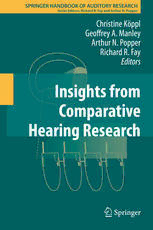
Insights from Comparative Hearing Research PDF
Preview Insights from Comparative Hearing Research
SPRINGER HANDBOOK OF AUDITORY RESEARCH Series Editors: Richard R. Fay and Arthur N. Popper Christine Köppl Geoff rey A. Manley Arthur N. Popper Richard R. Fay Editors Insights from Comparative Hearing Research Springer Handbook of Auditory Research For furthervolumes: http://www.springer.com/series/2506 Christine Ko¨ppl (cid:129) Geoffrey A. Manley Arthur N. Popper (cid:129) Richard R. Fay Editors Insights from Comparative Hearing Research With 95 Illustrations Editors ChristineKo¨ppl GeoffreyA.Manley DepartmentofNeuroscience DepartmentofNeuroscience SchoolofMedicineandHealthScience SchoolofMedicineandHealthScience andResearchCenter andResearchCenter NeurosensoryScience NeurosensoryScience CarlvonOssietzkyUniversity CarlvonOssietzkyUniversity Oldenburg,Germany Oldenburg,Germany ArthurN.Popper RichardR.Fay DepartmentofBiology MarineBiologicalLaboratory UniversityofMaryland WoodsHole,MA,USA CollegePark,MD,USA ISSN0947-2657 ISSN2197-1897(electronic) ISBN978-1-4614-9076-0 ISBN978-1-4614-9077-7(eBook) DOI10.1007/978-1-4614-9077-7 SpringerNewYorkHeidelbergDordrechtLondon LibraryofCongressControlNumber:2013954959 ©SpringerScience+BusinessMediaNewYork2014 Thisworkissubjecttocopyright.AllrightsarereservedbythePublisher,whetherthewholeorpart of the material is concerned, specifically the rights of translation, reprinting, reuse of illustrations, recitation,broadcasting,reproductiononmicrofilmsorinanyotherphysicalway,andtransmissionor informationstorageandretrieval,electronicadaptation,computersoftware,orbysimilarordissimilar methodologynowknownorhereafterdeveloped.Exemptedfromthislegalreservationarebriefexcerpts inconnectionwithreviewsorscholarlyanalysisormaterialsuppliedspecificallyforthepurposeofbeing enteredandexecutedonacomputersystem,forexclusiveusebythepurchaserofthework.Duplication ofthispublicationorpartsthereofispermittedonlyundertheprovisionsoftheCopyrightLawofthe Publisher’s location, in its current version, and permission for use must always be obtained from Springer.PermissionsforusemaybeobtainedthroughRightsLinkattheCopyrightClearanceCenter. ViolationsareliabletoprosecutionundertherespectiveCopyrightLaw. The use of general descriptive names, registered names, trademarks, service marks, etc. in this publicationdoesnotimply,evenintheabsenceofaspecificstatement,thatsuchnamesareexempt fromtherelevantprotectivelawsandregulationsandthereforefreeforgeneraluse. While the advice and information in this book are believed to be true and accurate at the date of publication,neithertheauthorsnortheeditorsnorthepublishercanacceptanylegalresponsibilityfor anyerrorsoromissionsthatmaybemade.Thepublishermakesnowarranty,expressorimplied,with respecttothematerialcontainedherein. Printedonacid-freepaper SpringerispartofSpringerScience+BusinessMedia(www.springer.com) ThisbookisdedicatedtoProfessorMasakazu (Mark)Konishi,BingProfessorofBehavioral BiologyEmeritus,Caltech,ontheoccasionof his 80th birthday in 2013. Mark’s work was instrumentalingreatlyfurtheringthestudyof both sound localization in the brain of the barn owl and the neural song and hearing system of song birds. Through his research work and that of his many students, comparative researchinhearingsystems was enormously advanced. (Photo courtesy of Catherine E. Carr) Series Preface The following preface is the one that we published in Volume 1 of the Springer Handbook of Auditory Research back in 1992. As anyone reading the original prefaceorthemanyusersoftheseries,willnote,wehavefarexceededouroriginal expectationofeightvolumes.Indeed,withbookspublishedtodate,andthoseinthe pipeline,wearenowsetformorethan50volumesinSHAR,andwearestillopen tonewandexcitingideasforadditionalbooks. Weareveryproudthatthereseemstobeconsensus,atleastamongourfriends and colleagues, that SHAR has become an important and influential part of the auditoryliterature.Whilewehaveworkedhardtodevelopandmaintainthequality and value of SHAR, the real value of the books is very much because of the numerous authors who have given their time to write outstanding chapters and to ourmanycoeditorswhohaveprovidedtheintellectualleadershiptotheindividual volumes.Wehaveworkedwitharemarkableandwonderfulgroupofpeople,many of whom have become great personal friends of both of us. We also continue to work with a spectacular group of editors at Springer, currently Melissa Higgs. Indeed, several of our past editors have moved on in the publishing world to become senior executives. To our delight, this includes the current president of SpringerUS,Dr.WilliamCurtis. But the truth is that the series would and could not be possible without the supportofourfamilies,andwewanttotakethisopportunitytodedicateallofthe SHARbooks,pastandfuture,tothem.Ourwives,CatherineFayandHelenPopper, andourchildren,MichellePopperLevit,MelissaPopperLevinsohn,ChristianFay, andAmandaFay,havebeenimmenselypatientaswedevelopedandworkedonthis series. We thank them, and state, without doubt, that this series could not have happened without them. We also dedicate the future of SHAR to our next gener- ation of (potential) auditory researchers—our grandchildren—Ethan and Sophie Levinsohn;EmmaLevit;andNathaniel,Evan,andStellaFay. vii viii SeriesPreface Preface 1992 The Springer Handbook ofAuditory Research presents aseries of comprehensive andsyntheticreviewsofthefundamentaltopicsinmodernauditoryresearch. The volumes are aimed at all individuals with interests in hearing research including advanced graduate students, postdoctoral researchers, and clinical investigators. The volumes are intended to introduce new investigators to important aspects of hearing science and to help established investigators to better understand the fundamental theories and data in fields of hearing that they may not normally followclosely. Each volumepresentsaparticulartopic comprehensively,andeach serves asa syntheticoverviewandguidetotheliterature.Assuch,thechapterspresentneither exhaustive data reviews nor original research that has not yet appeared in peer- reviewed journals. The volumes focus on topics that have developed a solid data and conceptual foundation rather than on those for which a literature is only beginningtodevelop.Newresearchareaswillbecoveredonatimelybasisinthe seriesastheybegintomature. Each volume intheseries consistsofafewsubstantialchaptersonaparticular topic.Insomecases,thetopicswillbeonesoftraditionalinterestforwhichthereis asubstantialbodyofdataandtheory,suchasauditoryneuroanatomy(Vol.1)and neurophysiology (Vol. 2). Other volumes in the series deal with topics that have beguntomaturemorerecently,suchasdevelopment,plasticity,andcomputational models of neural processing. In many cases, the series editors are joined by a coeditorhavingspecialexpertiseinthetopicofthevolume. ArthurN.Popper,CollegePark,MD RichardR.Fay,WoodsHole,MA SHARlogobyMarkB.Weinberg,Bethesda,Maryland,usedwithpermission. Volume Preface Choosing the appropriate animal model(s) is the central aim of comparative research.Theclassiccomparativeapproachinvolvesstudyinganimalswithdiffer- ent, but carefully chosen, phylogenetic backgrounds, thereby deducing principles thatareeitherbasic,andthussharedbycommondescent,orspecializationsthatare noveltoaparticulargroup.Evenifthepredominantmotivationisbiomedical,basic mechanismscanbestudiedproductivelyinawidevarietyofspeciesandthechoice maybedominatedbyfactorssuchaseaseofaccessandphysiologicalrobustness. The hearing organs of nonmammals, which show quite large and systematic differences from each other and from those of mammals, provide an invaluable basis for comparisons of structure and function. By taking advantage of the vast diversity of possible study organisms provided by the “library” that is biological diversity,itispossibletolearnhowcomplexfunctionsarerealizedintheinnerear throughtheevolutionofspecificstructural,cellular,andmolecularconfigurations. In addition, there is abundant evidence that the results of comparative research have,inthepast,supportedandhelpedinterpretationsofresearchonmammalsand humans. The purpose of this volume is to bring together some of the most exciting comparative research on hearing and to show how this work has profoundly impactedourunderstandingofhearinginallvertebrates.Thus,unlikemostearlier SHAR volumes, this volume is not centered on one coherent topic but focuses instead on a range of examples that highlight particular recent contributions of comparativeworktoseveraltopicsinauditoryresearch. Inthefirstchapter,Ko¨pplandManleyintroducethecomparativeapproachand document its contributions to hearing, while also introducing the themes of this volume.Thefirstsuchthemefocusesonhaircells.Inthenextchapter,Kavlieand Albert describe what is known about micromechanics, transduction, and active processesininsectauditoryreceptorsanddiscussthesefortheinsightstheyprovide intoauditoryprocessingingeneral.ThisisfollowedbyachapterinwhichRussell proposes that prestins play a role in frequency selectivity, and it is the capture of this function by prestin that has enabled the great expansion of sensitivity toward higher frequencies in mammalian ears. Hair cells continue as a theme in ix
